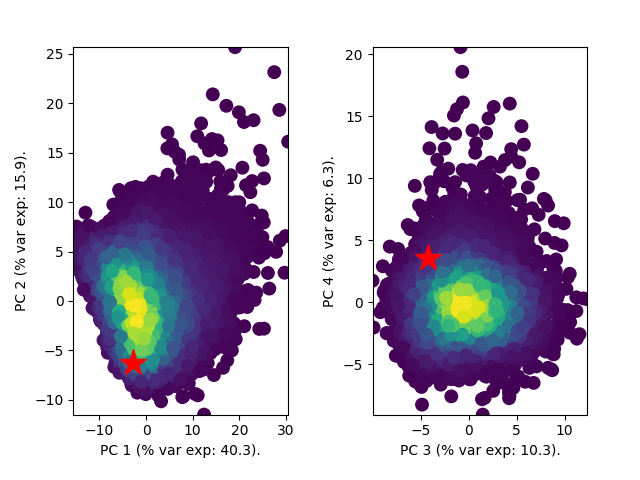PhyloDeep is a python library for parameter estimation and model selection from phylogenetic trees, based on deep learning.
Voznica J, Zhukova A, Boskova V, Saulnier E, Lemoine F, Moslonka-Lefebvre M, Gascuel O. Deep learning from phylogenies to uncover the transmission dynamics of epidemics. Nat Commun 13, 3.86 (2022)
The installation time of the package can be up to several minutes, including downloading dependencies. The run time should be a couple of seconds. The package was tested in Linux (Ubuntu 18.08), Windows 10 and MacOS.
For Windows users, we recommend installing phylodeep via Cygwin environment. First install Python>=3.8 and pip3 from the Cygwin packages. Then install phylodeep:
pip3 install phylodeepYou can install phylodeep for Python (version 3.8 or higher) with or without conda, following the procedures described below:
Once you have conda installed, create an environment for phylodeep with Python>=3.8 (here we name it phyloenv):
conda create --name phyloenv python=3.8Then activate it:
conda activate phyloenvThen install phylodeep in it:
pip install phylodeepMake sure that Python>=3.8 and pip3 are installed, then install phylodeep:
pip3 install phylodeepIf you installed phylodeep with conda, do not forget to activate the corresponding environment (e.g. phyloenv) before using PhyloDeep:
conda activate phyloenvWe recommend to perform a priori model adequacy first to assess whether the input data resembles well the simulations on which the neural networks were trained.
Here, we use an HIV tree reconstructed from 200 sequences, published in "Phylodynamics on local sexual contact networks" by Rasmussen et al. [PLoS Comput. Biol. 2017], which you can find at PairTree GitHub and in test_tree_HIV_Zurich/Zurich.trees.
from phylodeep import BD, BDEI, BDSS, FULL
from phylodeep.checkdeep import checkdeep
from phylodeep.modeldeep import modeldeep
from phylodeep.paramdeep import paramdeep
path_to_tree = './Zurich.trees'
# set presumed sampling probability
sampling_proba = 0.25
# a priori check for models BD, BDEI, BDSS
checkdeep(path_to_tree, model=BD, outputfile_png='BD_a_priori_check.png')
checkdeep(path_to_tree, model=BDEI, outputfile_png='BDEI_a_priori_check.png')
checkdeep(path_to_tree, model=BDSS, outputfile_png='BDSS_a_priori_check.png')
# model selection
model_BDEI_vs_BD_vs_BDSS = modeldeep(path_to_tree, sampling_proba, vector_representation=FULL)
# the selected model is BDSS
# parameter inference
param_BDSS = paramdeep(path_to_tree, sampling_proba, model=BDSS, vector_representation=FULL,
ci_computation=True)
# for the interpretation of results, please see below# we use here a tree of 200 tips
# a priori model adequacy check: highly recommended
checkdeep -t ./Zurich.trees -m BD -o BD_model_adequacy.png
checkdeep -t ./Zurich.trees -m BDEI -o BDEI_model_adequacy.png
checkdeep -t ./Zurich.trees -m BDSS -o BDSS_model_adequacy.png
# model selection
modeldeep -t ./Zurich.trees -p 0.25 -v CNN_FULL_TREE -o model_selection.csv
# parameter inference
paramdeep -t ./Zurich.trees -p 0.25 -m BDSS -v FFNN_SUMSTATS -o HIV_Zurich_BDSS_FFNN.csv
paramdeep -t ./Zurich.trees -p 0.25 -m BDSS -v CNN_FULL_TREE -o HIV_Zurich_BDSS_CNN_CI.csv -cThe a priori model adequacy check results in the following figures:
For the three models (BD, BDEI and BDSS), HIV tree datapoint (represented by a red star) is well inside the data cloud of simulations, where warm colors correspond to high density of simulations. The simulations and HIV tree datapoint were in the form of summary statistics prior to applying PCA. All three models thus pass the model adequacy check.
We then apply model selection using the full tree representation and obtain the following result:
| Model | Probability BDEI | Probability BD | Probability BDSS |
|---|---|---|---|
| Predicted probability | 0.00 | 0.00 | 1.00 |
The BDSS probability is by far the highest: it is the BDSS model that is confidently selected
Finally, under the selected model BDSS, we predict parameter values together with 95% CIs:
| R naught | Infectious period | X transmission | Superspreading fraction | |
|---|---|---|---|---|
| predicted value | 1.69 | 9.78 | 9.34 | 0.079 |
| CI 2.5% | 1.40 | 8.12 | 6.65 | 0.050 |
| CI 97.5% | 2.08 | 12.26 | 10 | 0.133 |
The point estimates for parameters that are no time related (R naught, X transmission and Superspreading fraction) are well inside the parameter ranges of simulations and thus seem valid (R naught between 1 and 5, x transmission between 3 and 10, superspreading fraction between 0.05 and 0.20).
The time related parameters (infectious and eventually incubation period for BDEI model) are in the same units as the branches of input tree, here in years (9.78 years). The covered parameter space for time related parameters is large due to internal rescaling of all input trees. It should apply to any tree.


